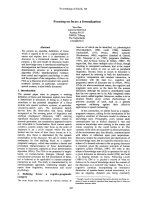Focusing on Customers
Bạn đang xem bản rút gọn của tài liệu. Xem và tải ngay bản đầy đủ của tài liệu tại đây (868.72 KB, 37 trang )
1
1
Chapter 4
Chapter 4
Focusing on
Focusing on
Customers
Customers
Key Idea
Key Idea
To create satisfied customers, the
organization needs to identify customers’
needs, design the production and service
systems to meet those needs, and
measure the results as the basis for
improvement.
3
Importance of Customer
Importance of Customer
Satisfaction and Loyalty
Satisfaction and Loyalty
“
“
Satisfaction is an attitude; loyalty is a
Satisfaction is an attitude; loyalty is a
behavior”
behavior”
Loyal customers spend more, are willing to
Loyal customers spend more, are willing to
pay higher prices, refer new clients, and are
pay higher prices, refer new clients, and are
less costly to do business with.
less costly to do business with.
It costs five times more to find a new
It costs five times more to find a new
customer than to keep an existing one
customer than to keep an existing one
happy.
happy.
A firm cannot create loyal customers without
A firm cannot create loyal customers without
first creating satisfied customers.
first creating satisfied customers.
Key Idea
Key Idea
Customer wants and needs drive
competitive advantage, and statistics
show that growth in market share is
strongly correlated with customer
satisfaction.
5
American Customer
American Customer
Satisfaction Index
Satisfaction Index
Measures customer satisfaction at national
Measures customer satisfaction at national
level
level
Introduced in 1994 by University of
Introduced in 1994 by University of
Michigan and American Society for Quality
Michigan and American Society for Quality
Continual decline in index from 1994
Continual decline in index from 1994
through 1998 with a small improvement
through 1998 with a small improvement
into 2000 suggests that quality
into 2000 suggests that quality
improvements have not kept pace with
improvements have not kept pace with
consumer expectations
consumer expectations
ACSI Model of Customer
ACSI Model of Customer
Satisfaction
Satisfaction
Perceived
quality
Customer
complaints
Perceived
value
Customer
satisfaction
Customer
expectations
Customer
loyalty
Key Idea
Key Idea
The econometric model used to produce
ACSI links customer satisfaction to its
determinants: customer expectations,
perceived quality, and perceived value.
Customer satisfaction, in turn, is linked to
customer loyalty, which has an impact on
profitability.
8
Customer-Driven Quality Cycle
Customer-Driven Quality Cycle
measurement and feedback
Customer needs and expectations
(expected quality)
Identification of customer needs
Translation into product/service specifications
(design quality)
Output (actual quality)
Customer perceptions (perceived quality)
PERCEIVED QUALITY is a comparison of ACTUAL
QUALITY to EXPECTED QUALITY
Key Idea
Key Idea
Many organizations still focus more on
processes and products from an internal
perspective, rather than taking the
perspective of the external customer.
Leading Practices
Leading Practices
(1 of 2)
(1 of 2)
Define and segment key customer groups
Define and segment key customer groups
and markets
and markets
Understand the voice of the customer
Understand the voice of the customer
(VOC)
(VOC)
Understand linkages between VOC and
Understand linkages between VOC and
design, production, and delivery
design, production, and delivery
Leading Practices
Leading Practices
(2 of 2)
(2 of 2)
Build relationships through
Build relationships through
commitments, provide accessibility to
commitments, provide accessibility to
people and information, set service
people and information, set service
standards, and follow-up on transactions
standards, and follow-up on transactions
Effective complaint management
Effective complaint management
processes
processes
Measure customer satisfaction for
Measure customer satisfaction for
improvement
improvement
Key Customer Groups
Key Customer Groups
Organization level
Organization level
–
consumers
consumers
–
external customers
external customers
–
employees
employees
–
society
society
Process level
Process level
–
internal customer units or groups
internal customer units or groups
Performer level
Performer level
–
individual internal customers
individual internal customers
Identifying Internal
Identifying Internal
Customers
Customers
What products or services are produced?
What products or services are produced?
Who uses these products and services?
Who uses these products and services?
Who do employees call, write to, or
Who do employees call, write to, or
answer questions for?
answer questions for?
Who supplies inputs to the process?
Who supplies inputs to the process?
14
AT&T Customer-Supplier
AT&T Customer-Supplier
Model
Model
Requirements
and feedback
Requirements
and feedback
Your
Suppliers
Your
Processes
Your
Customers
Inputs Outputs









